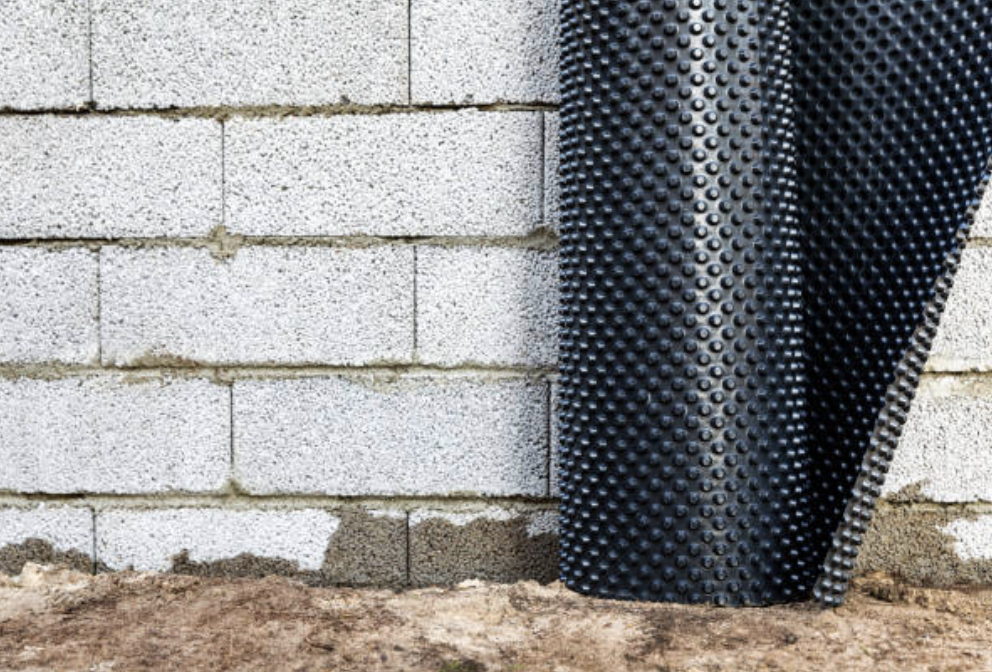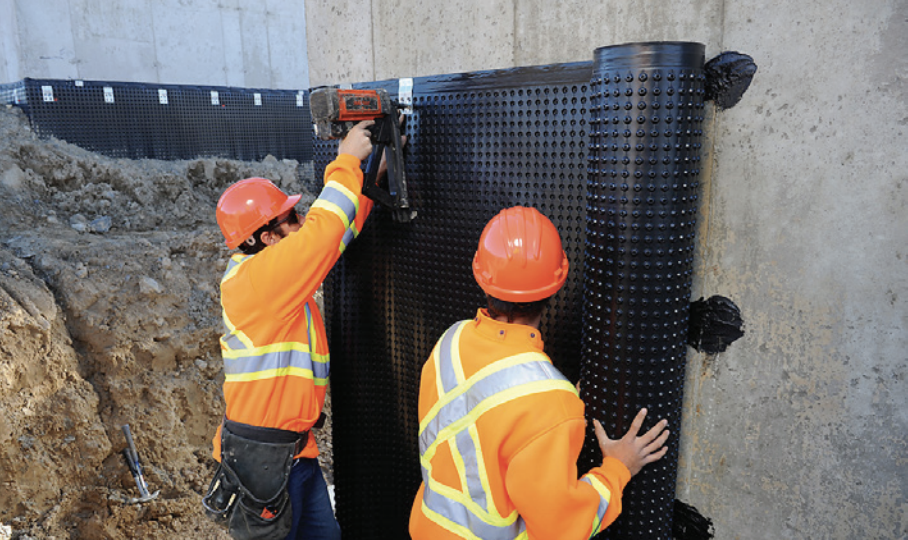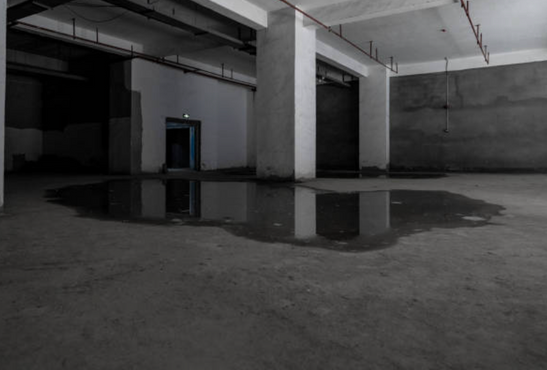Posted by Spycor Building on May 21st 2025

Is your basement constantly damp, with musty odors, condensation, or visible water stains on the walls and floors? You’re not alone. Thousands of homeowners deal with this frustrating issue every year, especially in areas with heavy rain, poor soil drainage, or aging homes. A wet basement is more than just a nuisance—it can lead to toxic mold growth, foundation cracks, wood rot, and significant structural damage if not addressed properly.
Understanding the top causes of a wet basement and how to fix them using reliable foundation waterproofing systems and drainage membranes is essential for protecting the health of your home—and your family. Whether you’re experiencing seasonal dampness or year-round moisture, there are proven solutions that work.
In this guide, we’ll explore why your basement is wet, the common causes of basement water intrusion, and the most effective ways to fix it for good—starting with exterior waterproofing, dimpled drainage membranes, and smart moisture management strategies.
Let’s dive in and help you take control of your wet basement before the damage worsens.
1. Poor Exterior Drainage
Heavy rainfall, melting snow, or poor yard grading can cause water to pool around your home’s foundation. Without proper slope or drainage systems in place, that water seeps into the soil and pushes against the basement walls. Over time, it finds its way into your home through cracks, construction joints, or porous concrete.
2. Hydrostatic Pressure
When groundwater accumulates around your foundation—especially in areas with high water tables—it creates hydrostatic pressure. This pressure builds until it forces water through basement walls and floors, even if no cracks are visible.
This is a common issue in homes near lakes, rivers, or coastal regions. To combat hydrostatic pressure, homeowners should consider installing both an interior drainage system (like a French drain) and exterior waterproofing solutions that relieve pressure and divert water away.
3. Foundation Cracks
Even small or hairline cracks in your foundation walls or slab can let in large amounts of moisture over time. These cracks may form due to natural soil settlement, shifting foundations, or freeze-thaw cycles that expand and contract concrete.
If you’ve noticed wet spots near cracks or efflorescence (white, chalky stains), water is already getting in. Fixing foundation cracks with injection sealing and applying a waterproof membrane on the exterior can help prevent future leaks and structural damage.
4. Inadequate Waterproofing
Many older homes were built using minimal damp-proofing methods like tar coatings or thin plastic sheeting. While these might delay water entry, they are no match for modern-day moisture levels and hydrostatic pressure.
Modern homes benefit from foundation waterproofing membranes like Platon Skid or DELTA®-MS, which provide full-coverage protection against water infiltration. These membranes create an air gap between the wall and the soil, helping water drain away from the structure instead of seeping in.
5. Faulty Gutters or Downspouts
Clogged gutters, broken downspouts, or poor gutter placement can cause water to overflow and dump near your home’s foundation—exactly where you don’t want it. This increases the risk of moisture buildup and leaks in the basement, especially during heavy rains.
Make sure your gutters are clean, your downspouts extend at least 4–6 feet from your foundation, and that water is properly directed to a drainage system. Simple maintenance can prevent thousands of dollars in future repairs.
How to Fix a Wet Basement with
Waterproofing and Drainage

Fixing a wet basement doesn’t have to be overwhelming—but it does require a strategic approach. The most effective long-term solutions involve both foundation waterproofing systems and proper drainage to stop water from entering in the first place. Below are the top five methods to permanently dry out your basement and protect your home’s foundation.
1. Install a Foundation Waterproofing Membrane
One of the most reliable solutions for keeping your basement dry is applying a foundation waterproofing membrane like DELTA®-MS. Made from tough, high-density polyethylene (HDPE), this membrane creates a dimpled air-gap that allows moisture to drain downward and away from your foundation.
Unlike traditional damp-proofing, which only slows moisture, a true waterproofing membrane blocks water infiltration entirely, shielding your basement walls from hydrostatic pressure and ground moisture. It’s the first line of defense in an exterior waterproofing system and a must-have for new builds or retrofit applications.
2. Use Drainage Mats or Drainage Boards
Pair your waterproofing membrane with a drainage mat or board such as Polyflow®, RESISTO, or Platon Skid. These drainage membranes help relieve hydrostatic pressure by creating a path for groundwater to flow to a French drain or sump pump system.
These mats are especially useful in high-water-table regions or areas with clay soil, which tends to hold moisture. When used together with foundation membranes, drainage boards form a complete waterproofing system that can last for decades.
3. Repair Foundation Cracks
Water will always find its way through cracks in your foundation walls or slab. These should be sealed as soon as possible to prevent ongoing water intrusion. Use epoxy injections or polyurethane sealants for smaller cracks.
For wider or structural cracks, it’s best to consult a foundation repair expert. Once repairs are complete, apply a waterproof coating or membrane to protect the repaired area from future damage.
4. Improve Exterior Drainage
Water should never pool near your foundation. If it does, you're inviting basement water problems. Regrade your yard so that it slopes at least 6 inches over the first 10 feet away from your home.
Install French drains, swales, or drainage trenches to help redirect water away. Downspouts should extend at least 4 to 6 feet from your home or connect to underground drainage lines to prevent runoff from seeping in at the foundation level.
5. Consider Interior Drainage Solutions
In some cases, especially where exterior excavation isn't feasible, an interior basement drainage system may be your best option. This often involves installing a perimeter drain tile system below the basement floor, connected to a sump pump that collects and expels groundwater.
When paired with vapor barriers on interior walls, this system keeps your basement dry even during heavy rainfall or snow melt. It’s also a solid secondary defense if your exterior waterproofing system is overwhelmed.
Why Act Now?

Delaying action on a wet basement is a costly mistake. Even minor water intrusion can lead to mold growth, rotting structural components, and long-term foundation damage. Over time, excess moisture can seep into drywall, insulation, and flooring—creating an unhealthy environment and reducing indoor air quality.
In many cases, homeowners don’t realize that up to 50% of indoor air originates from the basement. This means that excess basement moisture doesn't just stay downstairs—it affects the air your family breathes every day. By investing in foundation waterproofing systems and drainage membranes now, you prevent expensive damage later. You also increase your home’s value, boost energy efficiency, and create a healthier living space—especially important if you're considering selling your home in the future.
CLICK HERE to check out the best foundation waterproofing membranes and drainage systems, carefully selected for durability, cost-efficiency, and high-performance moisture protection!



